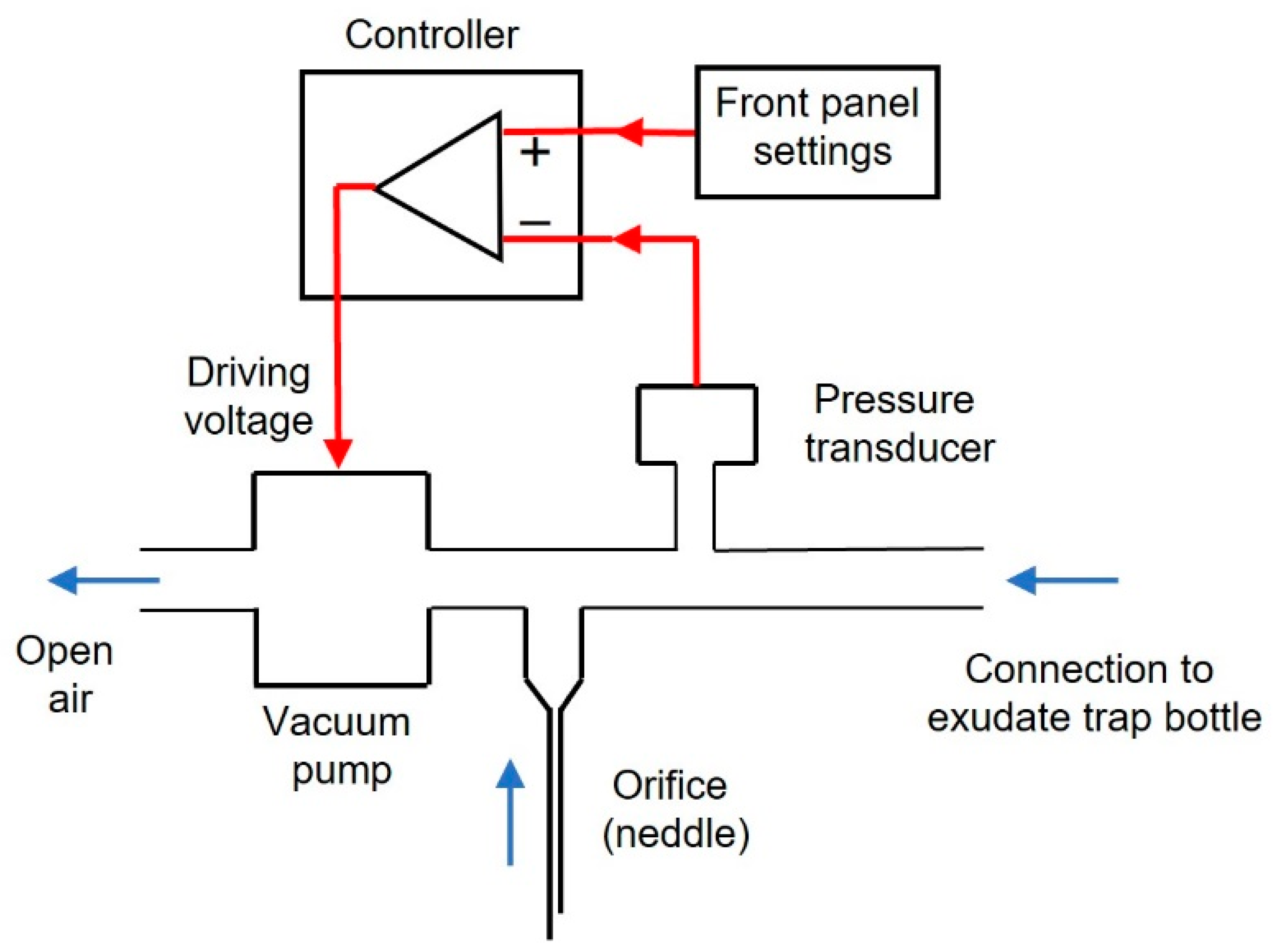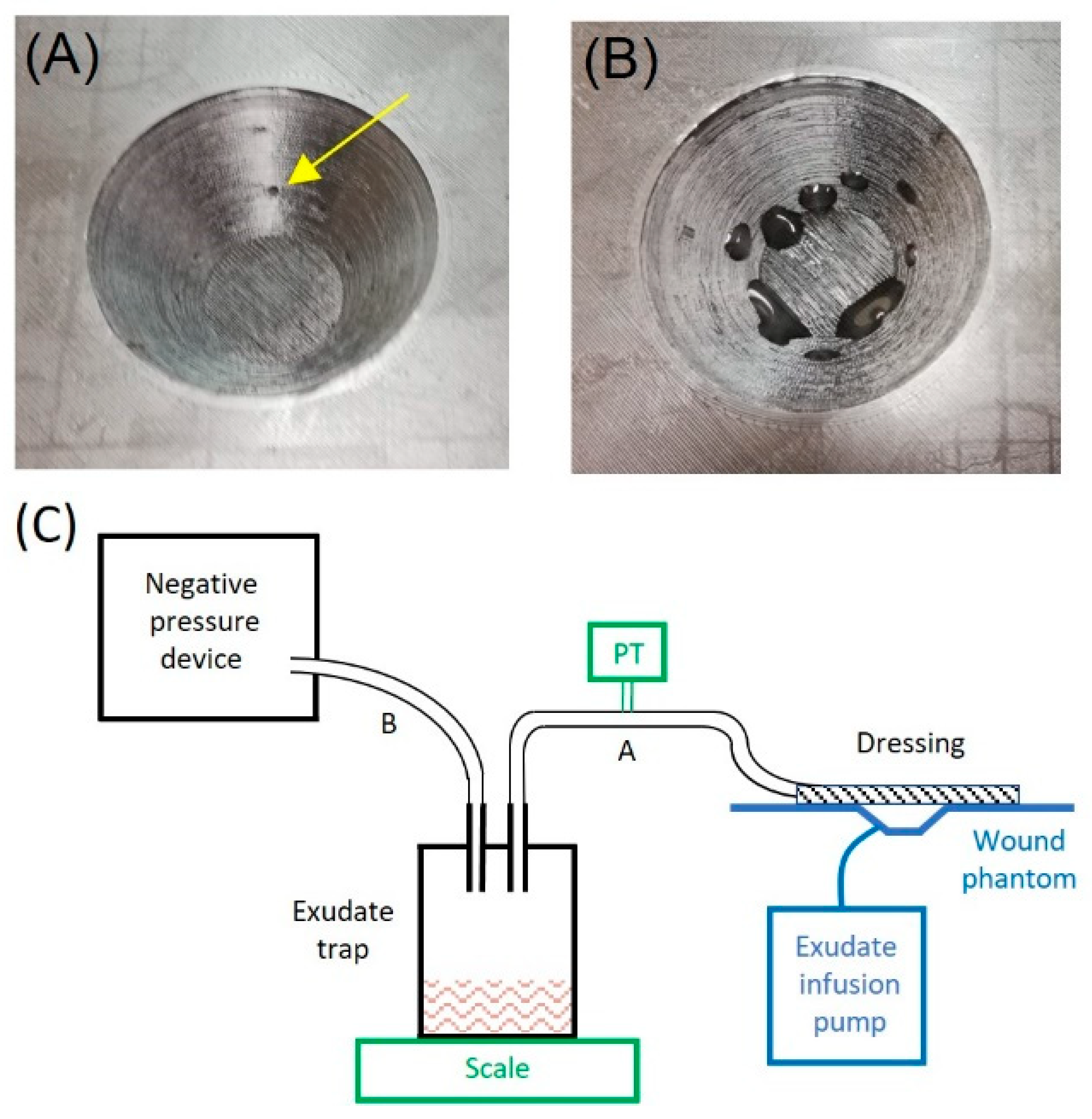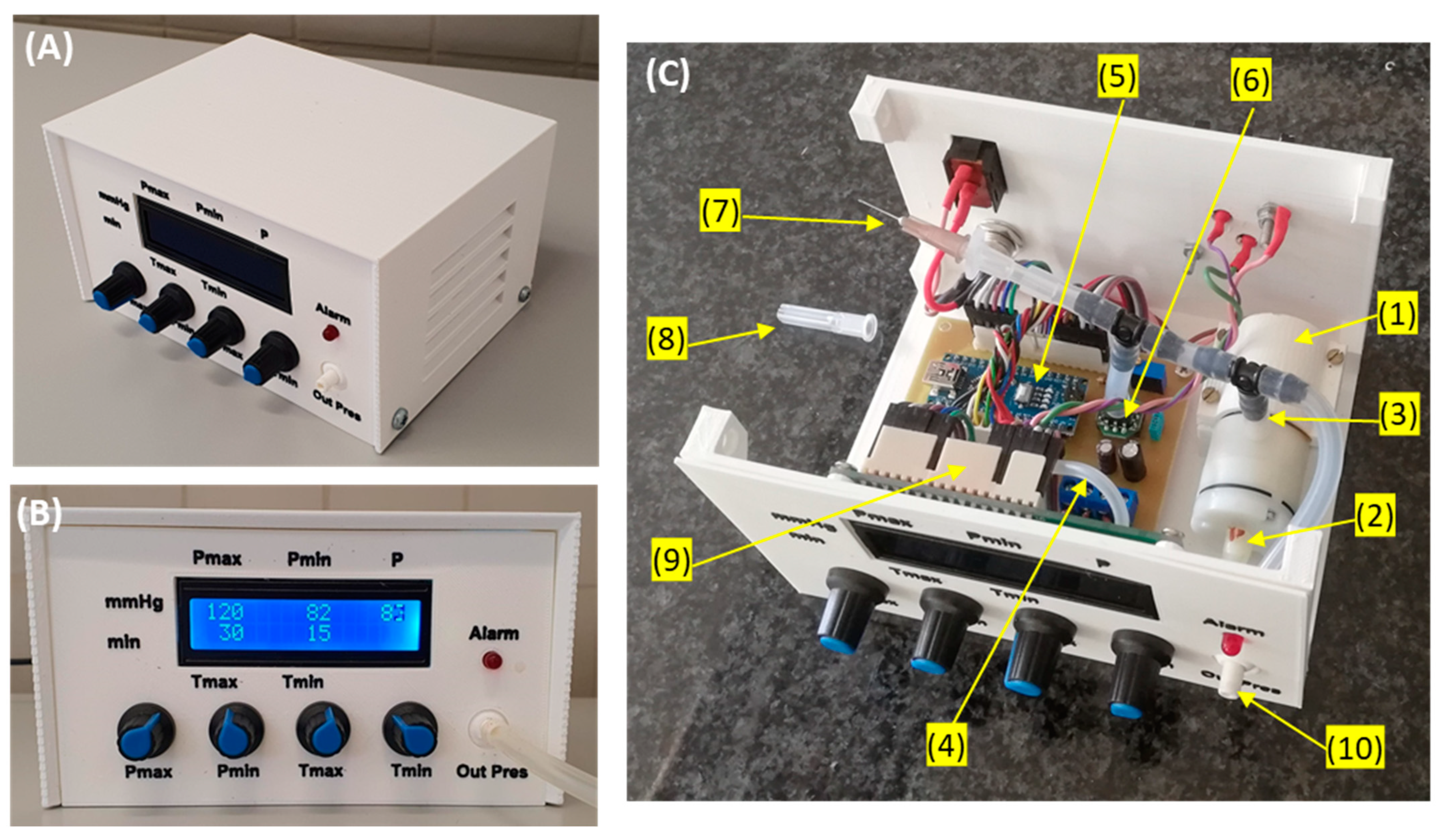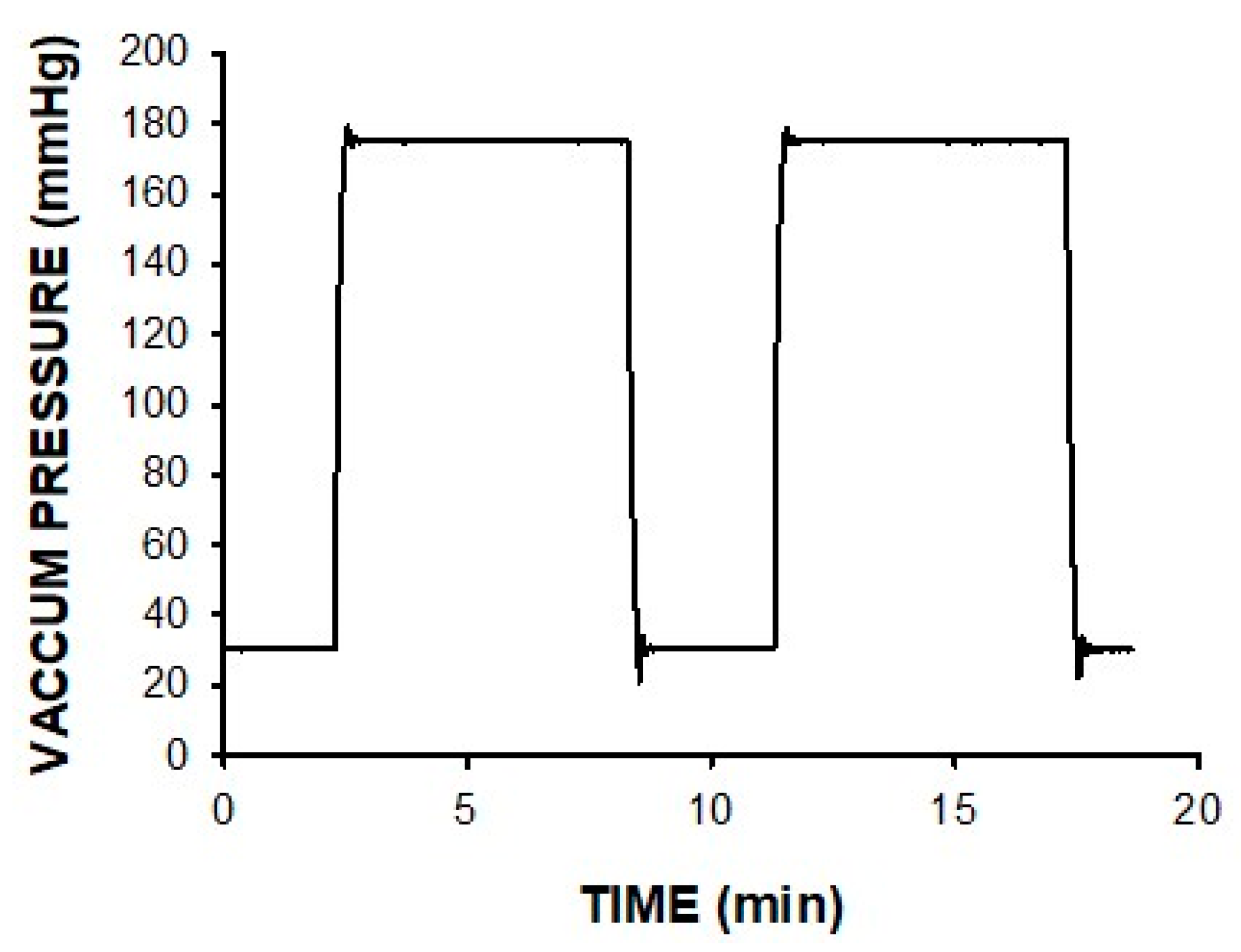Device for Negative Pressure Wound Therapy in Low-Resource Regions: Open-Source Description and Bench Test Evaluation
Abstract
1. Introduction
2. Materials and Methods
3. Results
4. Discussion
5. Conclusions
Supplementary Materials
Author Contributions
Funding
Institutional Review Board Statement
Informed Consent Statement
Data Availability Statement
Conflicts of Interest
References
- Apelqvist, J.; Willy, C.; Fagerdahl, A.M.; Fraccalvieri, M.; Malmsjö, M.; Piaggesi, A.; Probst, A.; Vowden, P. EWMA Document: Negative Pressure Wound Therapy. J. Wound Care 2017, 26, S1–S154. [Google Scholar] [CrossRef] [PubMed]
- Agarwal, P.; Kukrele, R.; Sharma, D. Vacuum assisted closure (VAC)/negative pressure wound therapy (NPWT) for difficult wounds: A review. J. Clin. Orthop. Trauma 2019, 10, 845–848. [Google Scholar] [CrossRef] [PubMed]
- Yadav, S.; Rawal, G.; Baxi, M. Vacuum assisted closure technique: A short review. Pan Afr. Med. J. 2017, 21, 246. [Google Scholar] [CrossRef] [PubMed]
- Lambert, K.; Hayes, P.; McCarthy, M. Vacuum assisted closure: A review of development and current applications. Eur. J. Vasc. Endovasc. Surg. 2005, 29, 219–226. [Google Scholar] [CrossRef]
- Poteet, S.J.; Schulz, S.A.; Povoski, S.P.; Chao, A.H. Negative pressure wound therapy: Device design, indications, and the evidence supporting its use. Expert Rev. Med. Devices 2021, 18, 151–160. [Google Scholar] [CrossRef]
- Borgquist, O.; Ingemansson, R.; Malmsjö, M. The influence of low and high pressure levels during negative-pressure wound therapy on wound contraction and fluid evacuation. Plast. Reconstr. Surg. 2011, 127, 551–559. [Google Scholar] [CrossRef]
- Normandin, S.; Safran, T.; Winocour, S.; Chu, C.K.; Vorstenbosch, J.; Murphy, A.M.; Davison, P.G. Negative Pressure Wound Therapy: Mechanism of Action and Clinical Applications. Semin. Plast. Surg. 2021, 35, 164–170. [Google Scholar] [CrossRef]
- Malmsjö, M.; Gustafsson, L.; Lindstedt, S.; Gesslein, B.; Ingemansson, R. The effects of variable, intermittent, and continuous negative pressure wound therapy, using foam or gauze, on wound contraction, granulation tissue formation, and ingrowth into the wound filler. Eplasty 2012, 12, e5. [Google Scholar]
- Lee, K.N.; Ben-Nakhi, M.; Park, E.J.; Hong, J.P. Cyclic negative pressure wound therapy: An alternative mode to intermittent system. Int. Wound J. 2015, 12, 686–692. [Google Scholar] [CrossRef]
- Sogorski, A.; Becker, A.; Dadras, M.; Wallner, C.; Wagner, J.M.; Glinski, M.V.; Lehnhardt, M.; Behr, B. Superior Enhancement of Cutaneous Microcirculation Due to “Cyclic” Application of a Negative Pressure Wound Therapy Device in Humans—Local and Remote Effects. Front. Surg. 2022, 3, 822122. [Google Scholar] [CrossRef]
- Maurya, S.; Bhandari, P.S. Negative Pressure Wound Therapy in the Management of Combat Wounds: A Critical Review. Adv. Wound Care 2016, 5, 379–389. [Google Scholar] [CrossRef] [PubMed]
- Älgå, A.; Haweizy, R.; Bashaireh, K.; Wong, S.; Lundgren, K.C.; von Schreeb, J.; Malmstedt, J. Negative pressure wound therapy versus standard treatment in patients with acute conflict-related extremity wounds: A pragmatic, multisite, randomised controlled trial. Lancet Glob. Health 2020, 8, e423–e429. [Google Scholar] [CrossRef]
- Gabriel, A.; Gialich, S.; Kirk, J.; Edwards, S.; Beck, B.; Sorocéanu, A.; Nelson, S.; Gabriel, C.; Gupta, S. The Haiti earthquake: The provision of wound care for mass casualties utilizing negative-pressure wound therapy. Adv. Ski. Wound Care 2011, 24, 456–462. [Google Scholar] [CrossRef] [PubMed]
- Zurovcik, D.R.; Mody, G.N.; Riviello, R.; Slocum, A. Simplified Negative Pressure Wound Therapy Device for Application in Low-Resource Settings. J. Orthop. Trauma 2015, 10, S33–S36. [Google Scholar] [CrossRef]
- Dejean, J.C.B.; Pean, J.M.-A.; Ottesen, T.D.; Woolley, P.M.; Qudsi, R.A.; Dyer, G.S. Advantages of a New Low-Cost Negative Pressure Wound Therapy Using the “Turtle VAC”: A Case Series. JBJS Case Connect. 2021, 11, e20. [Google Scholar] [CrossRef]
- Chaudhary, S.; Kumar, V.; Gandhi, P.; Koichade, M.; Mandal, S. Low cost, modified negative pressure wound therapy in infected orthopaedic wounds: Can it be as effective as its costly counterparts? J. Clin. Orthop. Trauma 2020, 11, S876–S882. [Google Scholar] [CrossRef]
- Kamamoto, F.; Lima, A.L.M.; de Rezende, M.R.; Mattar-Junior, R.; Leonhardt, M.D.C.; Kojima, K.E.; dos Santos, C.C. A new low-cost negative-pressure wound therapy versus a commercially available therapy device widely used to treat complex traumatic injuries: A prospective, randomized, non-inferiority trial. Clinics 2017, 72, 737–742. [Google Scholar] [CrossRef]
- Cocjin, H.G.B.; Jingco, J.K.P.; Tumaneng, F.D.C.; Coruña, J.M.R. Wound-Healing Following Negative-Pressure Wound Therapy with Use of a Locally Developed AquaVac System as Compared with the Vacuum-Assisted Closure (VAC) System. J. Bone Jt. Surg. Am. 2019, 101, 1990–1998. [Google Scholar] [CrossRef]
- Harris, T.G.; Pyle, C. Sharing Cost-Effective Alternatives for the Patient’s Benefit: Any Problem Can Be Solved with a Little Ingenuity. J. Bone Jt. Surg. Am. 2019, 101, e123. [Google Scholar] [CrossRef] [PubMed]
- Lustig, A.; Alves, P.; Call, E.; Santamaria, N.; Gefen, A. The sorptivity and durability of gelling fibre dressings tested in a simulated sacral pressure ulcer system. Int. Wound J. 2021, 18, 194–208. [Google Scholar] [CrossRef]
- Malmsjö, M.; Huddleston, E.; Martin, R. Biological effects of a disposable, canisterless negative pressure wound therapy system. Eplasty 2014, 14, e15. [Google Scholar] [PubMed]
- Tran, V.-T.; Ravaud, P. Frugal innovation in medicine for low resource settings. BMC Med. 2016, 14, 102. [Google Scholar] [CrossRef] [PubMed]
- Hindocha, C.N.; Antonacci, G.; Barlow, J.; Harris, M. Defining frugal innovation: A critical review. BMJ Innov. 2021, 7, 647–656. [Google Scholar] [CrossRef]
- Farré, R.; Trias, G.; Solana, G.; Ginovart, G.; Gozal, D.; Navajas, D. Novel approach for providing pediatric continuous positive airway pressure devices in low-income, under resourced regions. Am. J. Respir. Crit. Care Med. 2019, 199, 118–120. [Google Scholar] [CrossRef]
- Farré, R.; Montserrat, J.M.; Solana, G.; Gozal, D.; Navajas, D. Easy-to-build and affordable continuous positive airway pressure CPAP device for adult patients in low-income countries. Eur. Respir. J. 2019, 53, 1802290. [Google Scholar] [CrossRef]
- Aymerich, C.; Rodríguez-Lázaro, M.; Solana, G.; Farré, R.; Otero, J. Low-Cost Open-Source Device to Measure Maximal Inspiratory and Expiratory Pressures. Front. Physiol. 2021, 12, 719372. [Google Scholar] [CrossRef]
- Garmendia, O.; Rodríguez-Lazaro, M.A.; Otero, J.; Phan, P.; Stoyanova, A.; Dinh-Xuan, A.T.; Gozal, D.; Navajas, D.; Montserrat, J.M.; Farré, R. Low-cost, easy-to-build noninvasive pressure support ventilator for under-resourced regions: Open source hardware description, performance and feasibility testing. Eur. Respir. J. 2020, 55, 2000846. [Google Scholar] [CrossRef]
- Farré, R.; Rodríguez-Lázaro, M.A.; Dinh-Xuan, A.T.; Pons-Odena, M.; Navajas, D.; Gozal, D. A Low-Cost, Easy-to-Assemble Device to Prevent Infant Hyperthermia under Conditions of High Thermal Stress. Int. J. Environ. Res. Public Health 2021, 18, 13382. [Google Scholar] [CrossRef]
- Farré, R.; Rodríguez-Lázaro, M.A.; Gozal, D.; Trias, G.; Solana, G.; Navajas, D.; Otero, J. Simple low-cost construction and calibration of accurate pneumotachographs for monitoring mechanical ventilation in low-resource settings. Front. Med. 2022, 9, 938949. [Google Scholar] [CrossRef]
- Farré, R.; Artigas, A.; Torres, A.; Albaiceta, G.M.; Dinh-Xuan, A.T.; Gozal, D. A simple procedure to measure the tidal volume delivered by mechanical ventilators: A tool for bedside verification and quality control. Arch. Bronconeumol. 2022, 22, S0300–S2896. [Google Scholar] [CrossRef]
- Pearce, J.M. Quantifying the value of open source hardware development. Mod. Econ. 2015, 6, 1–11. [Google Scholar] [CrossRef]
- Pearce, J.M. Maximizing returns for public funding of medical research with open-source hardware. Health Policy Technol. 2017, 6, 381–382. [Google Scholar] [CrossRef]
- Niezen, G.; Eslambolchilar, P.; Thimbleby, H. Open-source hardware for medical devices. BMJ Innov. 2016, 2, 78–83. [Google Scholar] [CrossRef] [PubMed]
- Mackintosh, M.; Tibandebage, P.; Njeru, M.K.; Kungu, J.K.; Israel, C.; Mujinja, P.G. Rethinking health sector procurement as developmental linkages in East Africa. Soc. Sci. Med. 2018, 200, 182–189. [Google Scholar] [CrossRef]
- De Maria, C.; Mazzei, D.; Ahluwalia, A. Open source biomedical engineering for sustainability in African healthcare: Combining academic excellence with innovation. In Proceedings of the ICDS, The Eighth International Conference on Digital Society, Barcelona, Spain, 23–27 March 2014; pp. 48–53. [Google Scholar]
- Clifford, K.L.; Zaman, M.H. Engineering, global health, and inclusive innovation: Focus on partnership, system strengthening, and local impact for SDGs. Glob. Health Action 2016, 19, 30175. [Google Scholar] [CrossRef]
- Farré, R.; Gozal, D.; Nguyen, V.H.; Pearce, J.M.; Dinh-Xuan, A.T. Open-source hardware may address the shortage in medical devices for patients with low-income and chronic respiratory diseases in low-resource countries. J. Pers. Med. 2022, 12, 1498. [Google Scholar] [CrossRef]
- Levinson, D.R. Comparison of Prices for Negative Pressure Wound Therapy Pumps; Office of Inspector General, Ed.; Department of Health and Human Services: Washington, DC, USA, 2009. Available online: https://oig.hhs.gov/oei/reports/oei-02-07-00660.pdf (accessed on 12 September 2022).



Publisher’s Note: MDPI stays neutral with regard to jurisdictional claims in published maps and institutional affiliations. |
© 2022 by the authors. Licensee MDPI, Basel, Switzerland. This article is an open access article distributed under the terms and conditions of the Creative Commons Attribution (CC BY) license (https://creativecommons.org/licenses/by/4.0/).
Share and Cite
Farré, R.; Rodríguez-Lázaro, M.A.; Gonzalez-Martin, J.; Castro, P.; Hospital, T.; Compta, Y.; Solana, G.; Gozal, D.; Otero, J. Device for Negative Pressure Wound Therapy in Low-Resource Regions: Open-Source Description and Bench Test Evaluation. J. Clin. Med. 2022, 11, 5417. https://doi.org/10.3390/jcm11185417
Farré R, Rodríguez-Lázaro MA, Gonzalez-Martin J, Castro P, Hospital T, Compta Y, Solana G, Gozal D, Otero J. Device for Negative Pressure Wound Therapy in Low-Resource Regions: Open-Source Description and Bench Test Evaluation. Journal of Clinical Medicine. 2022; 11(18):5417. https://doi.org/10.3390/jcm11185417
Chicago/Turabian StyleFarré, Ramon, Miguel A. Rodríguez-Lázaro, Julian Gonzalez-Martin, Pedro Castro, Teresa Hospital, Yaroslau Compta, Gorka Solana, David Gozal, and Jorge Otero. 2022. "Device for Negative Pressure Wound Therapy in Low-Resource Regions: Open-Source Description and Bench Test Evaluation" Journal of Clinical Medicine 11, no. 18: 5417. https://doi.org/10.3390/jcm11185417
APA StyleFarré, R., Rodríguez-Lázaro, M. A., Gonzalez-Martin, J., Castro, P., Hospital, T., Compta, Y., Solana, G., Gozal, D., & Otero, J. (2022). Device for Negative Pressure Wound Therapy in Low-Resource Regions: Open-Source Description and Bench Test Evaluation. Journal of Clinical Medicine, 11(18), 5417. https://doi.org/10.3390/jcm11185417








